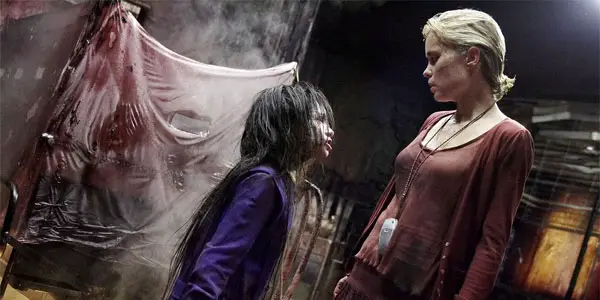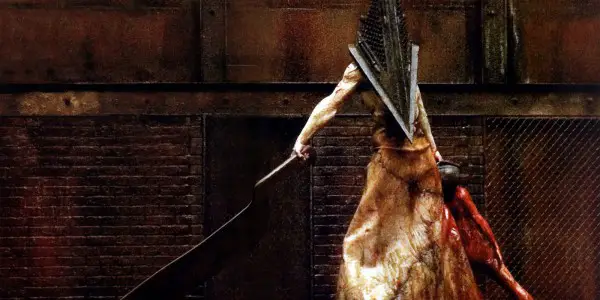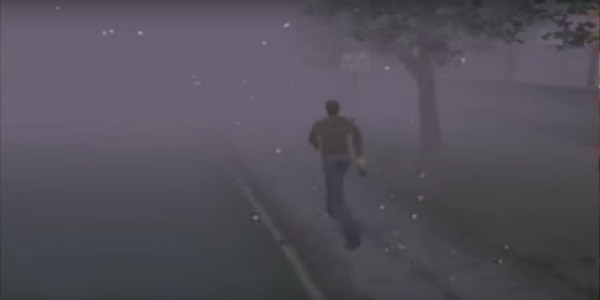Video Game Adaptations: Why Silent Hill The Movie Worked

Michael Pementel is a Columbia College Chicago graduate of the…
I appreciate video game movie adaptations. I’ve never identified with the crowd that whines and complains about the level of authenticity that the movie pays to the game. It has never bothered me that characters from different entries of a game series may appear in a different installment’s story. For me, it is all about being entertained, and feeling at least a little bit of the vibe from the original work.
One of my all-time favorite video game series is Silent Hill. For those of you who need a little bit of an introduction, Silent Hill is one of video game’s most iconic and beloved horror franchises. In some sense, a majority of the games take place in the town of Silent Hill, where supernatural horrors occur.
Being a big time horror lover, the game drew me in with its dread-ridden atmosphere and somber storytelling. The game’s dark psychological depths in exploring hopeless characters and grotesque demons immediately lured me into a beautiful nightmarish world.
So I was pretty excited when they announced the Silent Hill movie back in 2006. I wasn’t concerned with how faithful the story or characters would be to the original products, but more excited to see what new tale would be told. I saw the movie on opening night, leaving afterwards pretty fulfilled.
Of all the video game movie adaptations, I find Silent Hill to be one of the more entertaining and faithful works to its original game counterparts. Not only does it pay tribute to a good chunk of the game’s story elements, but it also captures the aura of the Silent Hill world.
Treading The Line Of Faithful Story Adaptation
Before diving into the the various stories of Silent Hill games, let’s start with the movie. The story starts with our protagonist Rose (Radha Mitchell) taking her daughter Sharon (Jodelle Ferland) to the town of Silent Hill. Sharon has been waking up sleep walking and yelling out the name Silent Hill, leading Rose to think that bringing her will lead to some sort of insight. Upon the two getting into a car accident right outside of the town, and Sharon disappearing, it is up to Rose to find and rescue her before it is too late.
[Spoilers for the movie and video game stories ahead]
As the movie progresses, Rose comes into contact with a cop that at first appears antagonistic, but then befriends her. The two then meet various residents of the town (which make up cultists and demons). Making her way through the town’s historic landmarks, Rose begins to piece together the horrors that have lead Silent Hill to become the nightmare it is today.
Rose learns that her daughter is part of a descendant of Silent Hill named Alessa, who was burned for being a bastard child (the idea of burning her as an act to purify her sin). This girl became so evil that she cast a curse upon the town, and in the hopes of saving whatever good was left, created an identical “good” part of herself (being Sharon).
For those who saw this movie and have played the games, they easily would have picked up on the similarities tied to the first entry in the series. In the game, we have our main character Harry and his daughter who get caught in a car accident, just to have the daughter disappear. Harry too runs into a cop, and he eventually learns that his daughter is also one with this being known as Alessa.
Off the bat, the game and the movie share pretty much the same storyline. Regardless of one protagonist being male, and one being female, it is still the fact that the protagonist is a parent that keeps a level of faithfulness to the adaptation. Where things begin to shift is when we get to our antagonist.
In the game, our main villain is Dahlia (who we learn is the mother of Alessa). She manipulates Harry after his daughter disappears, using him to locate Alessa and trap her (since he is the only one who can get close to her). We learn that Dahlia is the leader of an evil cult that attempts to revive their god (seemingly tied to Alessa).
In the movie, the villain is Christabella (Alice Krige), a leader of the town’s cult. Rose comes across Christabella by coincidence, only confronting her when Christabella learns of how similar Sharon looks like Alessa, aiming to burn her alive.
For the movie, Dahlia (Debrah Kara Unger) is still the mother of Alessa, and only offers her up to the cult in fear of retaliation (not in a means to find power). This is one of the bigger changes that the movie takes on compared to the game. Why the filmmakers decided to take on this change? Who knows for sure.
It very well could have to do with how the original story was much more graphic in its cult/demonic tone.
Seven years prior to the events in the Silent Hill video game, Dahlia traps Alessa, and conducts a ritual that impregnates her with the cult’s deity through immolation. Dahlia’s goal is to combine Alessa with Harry’s daughter, and revive the deity. In the movie, Christabella acts out towards Sharon and Rose just as a fanatic. Alessa already exists as the town’s deity, and the cult strives to repress her power.
Given the graphic nature of impregnating a child through immolation, it could be understood why the producers thought to alter the story for the movie just a tad. That being said, there is one alteration to the picture that I know irked some fans, more along the lines of honesty to the game series. This change was easily a ploy to help lure in fans, due to a popular piece of horror eye candy from the Silent Hill lore: Pyramid Head.

The iconic villain is known for carrying a massive blade, while wearing a pretty massive pyramid shaped metal head piece. He trudges his way towards the player, looming about various rooms with fierce rage and terror. While he is easily one of the most bad ass villains in gaming history, some fans weren’t pleased to see him in the movie.
Those fans knew why it would be impossible for Pyramid Head to appear in any other installment that had no ties to the video game Silent Hill 2.
Without diving into a ton of plot elements, Pyramid Head is a bad guy only in Silent Hill 2, due to the fact that he is a mental manifestation of the main character. Pyramid Head has been said to represent that character’s inner guilt and anger, hence why Pyramid Head only appears to them. To include the demon in anything else, without that character involved, would not make any sense.
From a business perspective, in attempting to make the movie catchy to video game fans and horror movie goers, I get it. It’s a popular character that is established as an icon in the universe. Honestly, I didn’t let this eat me up, and just went with it (I knew there was bound to be a twist or two that might appear).
Overall, I actually thought the Silent Hill movie was a pretty strong adaptation. Minus Pyramid Head, the antagonist switch, and some minor plot details, the movie keeps pretty strongly to that of the first game. But what makes the Silent Hill movie unique, along with its story, is the environment. The world of Silent Hill is unlike any other, full of despair and sorrow.
Recreating A World Of Pain, Agony, And Shadows
The main elements to a Silent Hill world are minimalism, light, and the score/music. As Rose enters the town, we see how a gray ashy sky looms above it. Against the color tones of old rotted out buildings, everything comes with a sense of cold and loneliness. For a town that has its various buildings (including that of a hospital, school, and hotel), it’s a fairly vacant place.

The movie has its cult members sure, but given the size of the town, the people make up a small population of what there once use to be. As Rose runs from building to building, making her way down the various alleys and streets, the emptiness provides a space for long takes, allowing room for the sound to build tension.
The game is known for an undertone of drone and grain, constantly shifting and scratching as the player progresses. This will shift at times to present an ambient flow that shimmers with tinges of melancholy. The movie portrays this element perfectly, playing at the right times to add tension to the minimalism, presenting the right tones to convey sorrow.
The score and music create a sincere aura of unease, producing anxiety and swirls of pain. In the video games, Silent Hill uses its mix visuals and sound to create feeling within its atmosphere.
What is also unique about the atmosphere of the games (that the movie also gets right), is the creepy awkwardness of the world’s characters. Silent Hill is home to some disturbing, troubled people. These people are the abused, the violent, and the possessed, lingering within the town, trapped in their torment.
The movie presents a small cast of characters that are fanatical, eerie, and present discomfort. Whether it is Christabella and her high and mighty outlandish ideals, or Dahlia’s slowly depleting sanity, the people of the town do not sit right. Their actions and dialogue create a distance from the viewer (and our main character), given their lack of what we deem “acceptable” societal interaction.
Silent Hill characters actually have quite a bit in common with David Lynch characters. If you need a sense of how a character in the games might act, look no further than the cast of Eraserhead, or the Mystery Man from Lost Highway.
Like the stories within the games, the atmosphere aims to create a space for players to become psychologically invested, and reflect on their own emotional presence (alongside the game characters).
The movie may lack the same intricacy that comes with the game, but it still gets that chilling and distant atmosphere right. What is most essential to a Silent Hill world is its setting, and it’s great to see how the movie really nailed it in this adaptation.
A Nightmare Well Told
I’ll always defend video game movie adaptations for the most part. I believe they are there purely as entertainment, and don’t have to be these high scale levels of artwork (if they achieve that, then that’s pretty awesome). I don’t get mad at these works for altering parts of the core story.
In the end, I just want to feel the essence of a world that I have invested myself into, and that’s what I got out of the Silent Hill movie. I felt a world that was similar to what I had experienced on my own, and I got to witness someone else’s interpretation. It was its own story, while still holding onto a level of faithfulness from the video games. The Silent Hill movies is fun, and to this day I re-watch it, basking in every moment of its horror.
What did you think of the Silent Hill movie? And what are your thoughts on video game movie adaptations? Tell us your thoughts in the comments below!
Does content like this matter to you?
Become a Member and support film journalism. Unlock access to all of Film Inquiry`s great articles. Join a community of like-minded readers who are passionate about cinema - get access to our private members Network, give back to independent filmmakers, and more.
Michael Pementel is a Columbia College Chicago graduate of the Creative Writing Program. With an immense love for pop and geek culture, he covers everything from film, video games, anime, and music. From editorials analyzing a given work, to digging into how our entertainment impacts us, he uses his writing to connect people with art. When he isn't writing, you can find him at the local movie theater with his fiancé, playing video games, or playing some sort of collectible trading card game. You can find more of his work here, as well as: FilmDaddy and New Noise Magazine.












